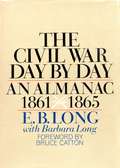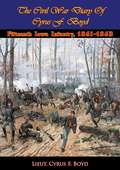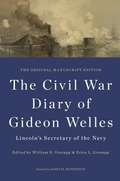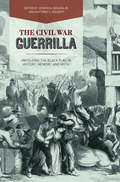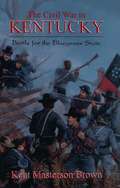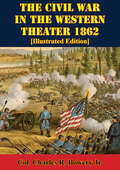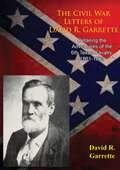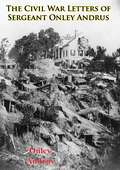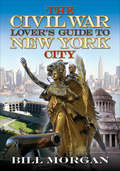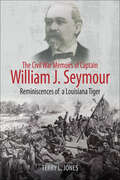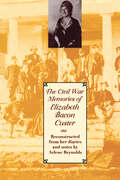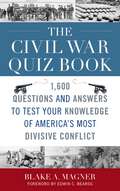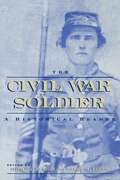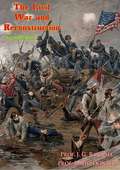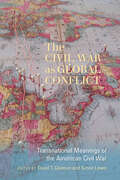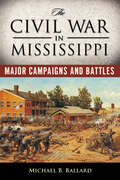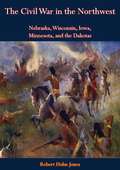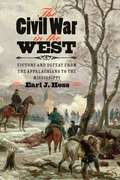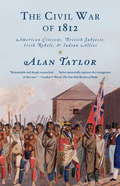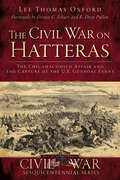- Table View
- List View
The Civil War Day by Day: 1861-1865
by E. B. Long Barbara LongIn all the vast collection of books on the American Civil War there is no book like this one. It has been needed for a long time, both by the student and by the man who simply likes to read about the Civil War, but until now no one had the dedication or the encyclopedic knowledge to produce it. Here it is, at last—an almanac, or day-by-day recital down to the close conflict, written by Professor E. B. Long of the University of Wyoming. If there was a battlefield in the Civil War that this man has not visited personally, I do not know where it is; if there is an important collection of papers shedding light on the war that he has not examined, it would be hard to name it. It is no exaggeration whatsoever to say that this man knows more facts about the Civil War than any other man who ever lived. To know a subject thoroughly, of course, is one thing; to put the results of that knowledge into lucid prose of manageable compass is something else again. One does not need to examine many pages of this almanac to realize that Professor Long has succeeded admirably in the second task. Crammed into the margins of each page with facts, this book is never soporific. It is for the casual reader as well as for the specialist; it can even, as a matter of fact, be read straight through as a narrative, in which the dramatic and heart-stirring events of America’s greatest time of trial pass before the eye on a day-to-day basis. A book like this has been needed for a long time, but up to now no one was able to write it. It should have a long life, and no one will ever need to do it again. It belongs on the somewhat restricted shelf of Civil War books that will be of permanent value.
The Civil War Diary Of Cyrus F. Boyd, Fifteenth Iowa Infantry, 1861-1863 [Illustrated Edition]
by Lieut. Cyrus F. BoydIncludes Civil War Map and Illustrations Pack - 224 battle plans, campaign maps and detailed analyses of actions spanning the entire period of hostilities."[One of] the Union side's most revealing and realistic views of soldier life....The diary is especially important for the light which it throws on such basic matters as the tortuous progression from civilian to veteran, the course of morale, the character of soldier life in a volunteer army, the quality of leadership, the awesomeness of battle, and the brutality of war."--Bell Irvin Wiley, in the Journal of Southern HistoryA native of Warren County, Iowa, Cyrus F. Boyd served a year and a half as an orderly sergeant with the Fifteenth Iowa Infantry before becoming first Lieutenant in Company B of the Thirty-fourth Iowa Infantry. His diary--expanded in 1896 from a pocket diary he carried on his campaigns from Indianola, Iowa, to Lake Providence, Louisiana--offers a full account of soldiering in the Union army. Before his promotion, Boyd was an intermediary between privates and company officers, a position that offered him unique opportunities to observe the attitudes and activities of both the unit leaders and their men. The outspoken Boyd frankly expresses his opinions of his comrades and his commanders, candidly depicts camp life, and intricately details the gory events on the battlefield. Although not always pleasant reading, The Civil War Diary of Cyrus F. Boyd is a vibrant, honest chronicle of one man's experiences in the bloody conflict.The diary has been heavily edited to ensure it can be understood, initially there was little to no punctuation included.
The Civil War Diary of Gideon Welles, Lincoln's Secretary of the Navy: The Original Manuscript Edition
by Gideon Welles William E. Gienapp Erica L. GienappGideon Welles's 1861 appointment as secretary of the navy placed him at the hub of Union planning for the Civil War and in the midst of the powerful personalities vying for influence in Abraham Lincoln's cabinet. Although Welles initially knew little of naval matters, he rebuilt a service depleted by Confederate defections, planned actions that gave the Union badly needed victories in the war's early days, and oversaw a blockade that weakened the South's economy. Perhaps the hardest-working member of the cabinet, Welles still found time to keep a detailed diary that has become one of the key documents for understanding the inner workings of the Lincoln administration. In this new edition, William E. and Erica L. Gienapp have restored Welles's original observations, gleaned from the manuscript diaries at the Library of Congress and freed from his many later revisions, so that the reader can experience what he wrote in the moment. With his vitriolic pen, Welles captures the bitter disputes over strategy and war aims, lacerates colleagues from Secretary of State William H. Seward to General-in-Chief Henry Halleck, and condemns the actions of the self-serving southern elite he sees as responsible for the war. He can just as easily wax eloquent about the Navy's wartime achievements, extoll the virtues of Lincoln, or drop in a tidbit of Washington gossip. Carefully edited and extensively annotated, this edition contains a wealth of supplementary material. The several appendixes include short biographies of the members of Lincoln's cabinet, the retrospective Welles wrote after leaving office covering the period missing from the diary proper, and important letters regarding naval matters and international law.
The Civil War Generals: Comrades, Peers, Rivals: In Their Own Words (Civil War America Ser.)
by Robert I. Girardi“An excellent contribution to Civil War literature . . . . [A]n excellent reference resource. Civil War buffs in particular will greatly enjoy this book.” —ArmchairGeneral.comThe Civil War Generals offers an unvarnished and largely unknown window into what military generals wrote and said about each other during the Civil War era. Drawing on more than 170 sources—including the letters, diaries, and memoirs of the general officers of the Union and Confederate armies, as well as their staff officers and other prominent figures—Civil War historian Robert Girardi has compiled a valuable record of who these generals were and how they were perceived by their peers. The quotations within paint revealing pictures of the private subjects at hand and, just as often, the people writing about them—a fascinating look at the many diverse personalities of Civil War leadership. More than just a collection of quotations, The Civil War Generals is also a valuable research tool, moving beyond the best-known figures to provide contemporary character descriptions of more than four hundred Civil War generals. The quotes range in nature from praise to indictment, and differing opinions of each individual give a balanced view, making the book both entertaining and informative. A truly one-of-a-kind compilation illustrated with approximately one hundred historical photographs, The Civil War Generals will find a home not only with the casual reader and history buff, but also with the serious historian and researcher.
The Civil War Guerrilla: Unfolding the Black Flag in History, Memory, and Myth (New Directions in Southern History)
by Joseph M. Beilein Jr. and Matthew C. HulbertCivil War historians shed new light on the importance of guerrilla combat across the south in this &“useful and fascinating work&” (Choice). Touching states from Virginia to New Mexico, guerrilla warfare played a significant yet underexamined role in the Civil War. Guerrilla fighters fought for both the Union and the Confederacy—as well as their own ethnic groups, tribes, or families. They were deadly forces that plundered, tortured, and terrorized those in their path, and their impact is not yet fully understood. This richly diverse volume assembles a team of both rising and eminent scholars to examine guerrilla warfare in the South during the Civil War. Together, they discuss irregular combat as practiced by various communities in multiple contexts, including how it was used by Native Americans, the factors that motivated raiders in the border states, and the women who participated as messengers, informants, collaborators, and combatants. They also explore how the Civil War guerrilla has been mythologized in history, literature, and folklore.
The Civil War In Kentucky: Battle For The Bluegrass State
by Kent Masterton BrownTop scholars contribute to this book of essays on the complex series of battles and political maneuvers for control of Kentucky during the Civil War.
The Civil War In The Western Theater 1862 [Illustrated Edition] (The U.S. Army Campaigns of the Civil War #2)
by Col. Charles R. Bowery Jr.Includes 8 maps and numerous other illustrationsThe Mississippi River had figured prominently in the North's strategic planning from the outset of the war. In May 1861, then-General in Chief of the U.S. Army Winfield Scott had drafted the so-called Anaconda Plan. Scott had proposed that the Federal armed forces squeeze the life out of the Confederacy by blockading the Southern coastline and launching an amphibious thrust down the Mississippi. He had argued that his plan would end the war with minimal bloodshed, conveniently ignoring the fact that it would take years for the North to build a sufficient navy. President Abraham Lincoln thought the Anaconda Plan had merit, but he knew that the Army would have to play a far more active role than Scott had envisioned--especially in Kentucky and Missouri--where Unionist and secessionist forces were already maneuvering for power.Lincoln was determined not only to keep the two crucial border states in the Union, but to rescue eastern Tennessee. One senator, Andrew Johnson, and one congressman, Horace Maynard, from that region remained in Washington to represent their Unionist supporters.On 4 August, Maj. Gen. George B. McClellan, the Army of the Potomac's new commander, presented his own strategic plan for the West that accorded with Lincoln's wishes yet proved more elaborate. He recommended a grand campaign involving two western armies--one based in Kentucky and the other in Missouri. The first army would divide into two columns in order to capture eastern Tennessee and Nashville. They would reunite at Chattanooga and proceed to Atlanta and then Montgomery, Alabama. After gaining control of Missouri, the second army would launch an amphibious expedition down the Mississippi River and seize New Orleans. All that remained was for the president to find generals willing and able to put these ambitious plans into action.
The Civil War Letters of David R. Garrette,: Detailing the Adventures of the 6th Texas Cavalry, 1861-1865
by David R. GarretteWith annotations and background information from the great grandson of David Garrett, this book details the adventures of the 6th Texas Cavalry (1861-1865) during the Civil War. It contributes to the soldier's viewpoint of the war; though beset by incredible hardships that soldier yet managed to find time to write the folks back home. The book includes a facsimile letter as well as maps, historic photographic images and genealogical information.
The Civil War Letters of Joseph Taylor
by Kevin C. MurphyLetters of a civil war Massachusetts soldier to his father
The Civil War Letters of Sergeant Onley Andrus
by Onley AndrusSergeant Andrus served in Co. D, 95th Illinois Infantry. Here are reprinted 61 letters written home during the war, beginning in September 1862 and continues through the end of the War. The regiment fought in the Vicksburg Campaign, the Red River Campaign, the pursuit of Sterling Price, Nashville, New Orleans, and Mobile.
The Civil War Lover's Guide to New York City
by Bill MorganThis fascinating illustrated guide is “a must for any Civil War buff visiting or living in New York City” (New York Journal of Books). Few Americans associate New York City with the Civil War, but the most populated metropolitan area in the nation, then and now, is filled with scores of monuments, historical sites, and resources directly related to those four turbulent years. Veteran author Bill Morgan’s The Civil War Lover’s Guide to New York City examines more than 150 of these largely overlooked and often forgotten historical gems. Morgan’s book takes readers on a journey of historical discovery. Walk inside the church where Stonewall Jackson was baptized, visit the building where Lincoln delivered his famous Cooper Union Speech, and marvel that the church built by the great abolitionist Henry Ward Beecher is still used for worship. A dozen Civil War–era forts still stand (the star-shaped bastion upon which the Statue of Liberty rests was a giant supply depot), and one of them sent relief supplies to besieged Fort Sumter in Charleston. Visit the theater where “Dixie” was first performed and the house where Stephen Crane wrote The Red Badge of Courage. After the war, New York honored the brave men who fought by erecting some of the nation’s most beautiful memorials in honor of William T. Sherman, Admiral David Farragut, and Abraham Lincoln. These and many others still grace parks and plazas around the city. Ulysses S. Grant adopted New York as his home and is buried here in the largest mausoleum in America (which was also the most-visited monument in the country). See the homes where many generals, including Winfield Scott, George B. McClellan, and even Robert E. Lee, once lived. Complete with full-color photos and maps, Morgan’s lavishly illustrated and designed volume is a must-have book for every student of the Civil War and for every visitor to New York City.
The Civil War Memoirs of Captain William J. Seymour: Reminiscences of a Louisiana Tiger
by Terry L. JonesA Confederate captain from the 1st Louisiana Brigade uses his skill as a newspaper editor to recount his experiences during the U.S. Civil War.Like many other soldiers who fought in the Civil War, New Orleans newspaper editor William J. Seymour left behind an account of his wartime experiences. It is the only memoir by any field or staff officer of the famous 1st Louisiana Brigade (Hays’ Brigade) in the Army of Northern Virginia. Long out of print, The Civil War Memoirs of Captain William J. Seymour: Reminiscences of a Louisiana Tiger is available once more in this updated and completely revised edition by award-winning author Terry L. Jones.Seymour’s invaluable narrative begins with his service as a volunteer aide to Confederate Gen. Johnson K. Duncan during the 1862 New Orleans campaign. Utilizing his journalistic background and eye for detail, Seymour recalls the siege of Fort Jackson (the only Southern soldier’s account except for official reports), the bickering and confusion among Confederate officers, and the subsequent mutiny and surrender of the fort’s defenders. Jailed after the fall of New Orleans for violating Maj. Gen. Ben Butler’s censorship order, Seymour was eventually released and joined General Hays’ staff in Virginia.Seymour’s memoirs cover his experiences in the army of Northern Virginia, including the campaigns of Chancellorsville, Gettysburg, Wilderness, and Shenandoah Valley, ending with the Battle of Cedar Creek in 1864. His pen recounts the activities of the Louisiana Brigade while offering a critical analysis of the tactics and strategies employed by the army.A perceptive and articulate officer, Seymour left behind an invaluable account of the Civil War’s drudgery and horror, pomp and glory. Terry L. Jones’ spare and judicious editing enhances Seymour’s memoirs to create an indispensable resource for Civil War historians and enthusiasts.
The Civil War Memories of Elizabeth Bacon Custer: Reconstructed From Her Diaries and Notes by Arlene Reynolds
by Elizabeth Bacon CusterThis collection of private writings by General Custer&’s wife offers an intimate look at their lives before and during the Civil War. In her first year of marriage (1864–1865) to General George Armstrong Custer, Libbie Custer witnessed the Civil War firsthand. Her experiences of danger, hardship, and excitement made ideal material for a book, one that she worked on later in life yet never published. In this volume, Arlene Reynolds presents a readable narrative of Libbie Custer's life during the war years by painstakingly reconstructing Libbie&’s original, unpublished notes and diaries found in the archives of the Little Big Horn Battlefield National Monument. In these reminiscences, Libbie Custer vividly describes her life both in camp and in Washington. She tells of incidents such as fording a swollen river sidesaddle on horseback, dancing at the Inaugural Ball near President Lincoln, and watching the massive review of the Army of the Potomac after the surrender. The resulting narrative tells the fascinating story of a sheltered girl's maturation into a courageous woman in the crucible of war. It also offers an intimate glimpse into the youth, West Point years, and early military service of General Custer.
The Civil War Quiz Book: 1,600 Questions and Answers to Test Your Knowledge of America's Most Divisive Conflict
by Blake A. MagnerIf you think you know a lot about the Civil War, challenge yourself with this instructive and intriguing book of questions. Covering every battle of the war, commanders and ordinary soldiers, weapons, and armies, this book will test the knowledge of even the most dedicated history buff. Degrees of difficulty range from elementary to questions that even the author had difficulty figuring out, and everything in between. Thousands of provocative questions will sharpen the knowledge of Civil enthusiasts everywhere.
The Civil War Soldier: A Historical Reader (American Ways Ser.)
by Michael Barton Larry M LogueAn anthology of landmark scholarship on the histories of the common soldier in the U.S. Civil WarIn 1943, Bell Wiley's groundbreaking book Johnny Reb launched a new area of study: the history of the common soldier in the U.S. Civil War. This anthology brings together landmark scholarship on the subject, from a 19th century account of life as a soldier to contemporary work on women who, disguised as men, joined the army. One of the only available compilations on the subject, The Civil War Soldier answers a wide range of provocative questions: What were the differences between Union and Confederate soldiers? What were soldiers' motivations for joining the army—their "will to combat"? How can we evaluate the psychological impact of military service on individual morale? Is there a basis for comparison between the experiences of Civil War soldiers and those who fought in World War II or Vietnam? How did the experiences of black soldiers in the Union army differ from those of their white comrades? And why were southern soldiers especially drawn to evangelical preaching? Offering a host of diverse perspectives on these issues, The Civil War Soldier is the perfect introduction to the topic, for the student and the Civil War enthusiast alike. Contributors: Michael Barton, Eric T. Dean, David Donald, Drew Gilpin Faust, Joseph Allen Frank, James W. Geary, Joseph T. Glaatthaar, Paddy Griffith, Earl J. Hess, Thomas Wentworth Higginson, Perry D. Jamieson, Elizabeth D. Leonard, Gerald F. Linderman, Larry Logue, Pete Maslowski, Carlton McCarthy, James M. McPherson, Grady McWhiney, Reid Mitchell, George A. Reaves, Jr., James I. Robertson, Fred A. Shannon, Maris A. Vinovskis, and Bell Irvin Wiley.
The Civil War and Reconstruction [Second Edition]
by Prof. J. G. Randall Prof. David DonaldThis is a revised edition by David Herbert Donald of his former professor J. G. Randall's book The Civil War and Reconstruction, which was originally published in 1937 and had long been regarded as "the standard work in its field", serving as a useful basic Civil War reference tool for general readers and textbook for college classes. This Second Edition retains many of the original chapters, "such as those treating border-state problems, non-military developments during the war, intellectual tendencies, anti-war efforts, religious and educational movements, and propaganda methods [...] bearing evidence of Mr. Randall's thoroughgoing exploration of the manuscripts and archives," whilst it expands considerably on other original chapters, such as those relating to the Confederacy. Still other portions have been entirely recast or rewritten, such as the pre-war period chapters and Reconstruction chapters, reflecting factual updates since Randall's original publication. A must-read for all Civil War students and scholars.
The Civil War and Reconstruction: A Documentary Collection
by William E. GienappAn ample, wide-ranging collection of primary sources, The Civil War and Reconstruction: A Documentary Collection, opens a window onto the political, social, cultural, economic, and military history from 1830 to 1877. Particular attention is paid to social history; coverage of the experience of African Americans, women, and non-elites provides a well-rounded picture of the period. Substantial selections, careful editing, and helpful annotations make this collection an ideal supplement for your course on the Civil War and Reconstruction.
The Civil War as Global Conflict: Transnational Meanings of the American Civil War (Carolina Lowcountry and the Atlantic World)
by David T. Gleeson and Simon LewisA collection of scholarly essays exploring the American Civil War from international perspectives.In an attempt to counter the insular narratives of much of the sesquicentennial commemorations of the Civil War in the United States, editors David T. Gleeson and Simon Lewis present this collection of essays that examine the war as more than a North American conflict, one with transnational concerns. The book, while addressing the origins of the Civil War, places the struggle over slavery and sovereignty in the United States in the context of other conflicts in the Western hemisphere. Additionally, Gleeson and Lewis offer an analysis of the impact of the war and its results overseas.Although the Civil War was the bloodiest conflict in US history and arguably its single most defining event, this work underscores the reality that the war was by no means the only conflict that ensnared the global imperial powers in the mid-nineteenth century. In some ways the Civil War was just another part of contemporary conflicts over the definitions of liberty, democracy, and nationhood.The editors have successfully linked numerous provocative themes and convergences of time and space to make the work both coherent and cogent. Subjects include such disparate topics as Florence Nightingale, Gone with the Wind, war crimes and racial violence, and choices of allegiance made by immigrants to the United States. While we now take for granted the nation’s values of freedom and democracy, we cannot understand the impact of the Civil War and the victorious “new birth of freedom” without thinking globally.The contributors to The Civil War as Global Conflict reveal that Civil War-era attitudes toward citizenship and democracy were far from fixed or stable. Race, ethnicity, nationhood, and slavery were subjects of fierce controversy. Examining the Civil War in a global context requires us to see the conflict as a seminal event in the continuous struggles of people to achieve liberty and fulfill the potential of human freedom. The book concludes with a coda that reconnects the global with the local and provides ways for Americans to discuss the war and its legacy more productively.Contributors: O. Vernon Burton; Edmund L. Drago; Hugh Dubrulle; Niels Eichhorn; W. Eric Emerson; Amanda Foreman; David T. Gleeson; Matthew Karp; Simon Lewis; Aaron W. Marrs; Lesley Marx; Joseph McGill; James M. McPherson; Alexander Noonan; Theodore N. Rosengarten; Edward B. Rugemer; Jane E. Schultz; Aaron Sheehan-Dean; Christopher Wilkins“The writers of this collection effectively balance local and global contexts to produce a significant text that is invaluable to any scholar interested in research desiring to move away from ‘pantomime-like North-South, black-white, blue-gray binaries.’” —Jesse Tyler Lobbs, Kansas State University
The Civil War at Perryville: Battling for the Bluegrass (Civil War Sesquicentennial Series)
by Christopher L KolakowskiA comprehensive history of the bloody Battle of Perryville, Kentucky, featuring over sixty historic images and maps.Desperate to seize control of Union-held Kentucky, a border state, the Confederate army launched an invasion into the commonwealth in the fall of 1862. The incursion viciously culminated at an otherwise quiet Bluegrass crossroads and forever altered the landscape of the war. The Battle of Perryville lasted just one day yet produced nearly eight thousand combined casualties and losses, and some say nary a victor. The Rebel army was forced to retreat, and the United States kept its imperative grasp on Kentucky throughout the war. Famous Confederate diarist Sam Watkins, whose Company Aytch journals were featured as a major narrative thread in Ken Burns&’ award-winning Civil War documentary series, declared Perryville the hardest fighting that he experienced. Indeed, history would record that Perryville the second bloodiest battle of the Western Theater after Shiloh. Few know this hallowed ground like Christopher L. Kolakowski, former director of the Perryville Battlefield Preservation Association, who draws on letters, reports, memoirs and other primary sources to offer the most accessible and engaging account of the Kentucky Campaign yet, featuring over sixty historic images and maps.
The Civil War in Mississippi: Major Campaigns and Battles (Heritage of Mississippi Series)
by Michael B. BallardFrom the first Union attack on Vicksburg in the spring of 1862 through Benjamin Grierson's last raid through Mississippi in late 1864 and early 1865, this book traces the campaigns, fighting, and causes and effects of armed conflict in central and North Mississippi, where major campaigns were waged and fighting occurred. The Civil War in Mississippi: Major Campaigns and Battles will be a must-read for any Mississippian or Civil War buff who wants the complete story of the Civil War in Mississippi. It discusses the key military engagements in chronological order. It begins with a prologue covering mobilization and other events leading up to the first military action within the state's borders. The book then covers all of the major military operations, including the campaign for and siege of Vicksburg, and battles at Iuka and Corinth, Meridian, Brice's Crossroads, and Tupelo. The colorful cast of characters includes such household names as Sherman, Grant, Pemberton, and Forrest, as well as a host of other commanders and soldiers. Author Michael B. Ballard discusses at length minority troops and others glossed over or lost in studies of the Mississippi military during the war.
The Civil War in the Northwest: Nebraska, Wisconsin, Iowa, Minnesota, and the Dakotas
by Robert Huhn JonesTHERE HAVE BEEN AT LEAST 34,000 volumes written on the Civil War, and the approaching centennial of that awesome event will insure the outpouring of many more. In this most explored facet of American history, it is curious that there still remain areas to examine, and people and events to reconsider, re-evaluate, and reinterpret. One of the neglected areas is the northwestern frontier. The problem is unusual, for there two turbulent streams of history, the frontier and the rebellion, converge and flow together until the newer ends in a muddy backwash as the older flows on. It is far too arbitrary to paddle one stream without the other, yet most often this has been done. The Civil War has been forgotten as historians probed the Indian massacre, or vice versa.
The Civil War in the West
by Earl J. HessThe Western theater of the Civil War, rich in agricultural resources and manpower and home to a large number of slaves, stretched 600 miles north to south and 450 miles east to west from the Appalachians to the Mississippi. If the South lost the West, there would be little hope of preserving the Confederacy. Earl J. Hess's comprehensive study of how Federal forces conquered and held the West examines the geographical difficulties of conducting campaigns in a vast land, as well as the toll irregular warfare took on soldiers and civilians alike. Hess balances a thorough knowledge of the battle lines with a deep understanding of what was happening within the occupied territories.In addition to a mastery of logistics, Union victory hinged on making use of black manpower and developing policies for controlling constant unrest while winning campaigns. Effective use of technology, superior resource management, and an aggressive confidence went hand in hand with Federal success on the battlefield. In the end, Confederates did not have the manpower, supplies, transportation potential, or leadership to counter Union initiatives in this critical arena.
The Civil War of 1812
by Alan TaylorIn this deeply researched and clearly written book, the Pulitzer Prize-winning historian Alan Taylor tells the riveting story of a war that redefined North America. During the early nineteenth century, Britons and Americans renewed their struggle over the legacy of the American Revolution. Soldiers, immigrants, settlers, and Indians fought in a northern borderland to determine the fate of a continent. Would revolutionary republicanism sweep the British from Canada? Or would the British empire contain, divide, and ruin the shaky American republic?In a world of double identities, slippery allegiances, and porous boundaries, the leaders of the republic and of the empire struggled to control their own diverse peoples. The border divided Americans--former Loyalists and Patriots--who fought on both sides in the new war, as did native peoples defending their homelands. Serving in both armies, Irish immigrants battled one another, reaping charges of rebellion and treason. And dissident Americans flirted with secession while aiding the British as smugglers and spies.During the war, both sides struggled to sustain armies in a northern land of immense forests, vast lakes, and stark seasonal swings in the weather. In that environment, many soldiers panicked as they fought their own vivid imaginations, which cast Indians as bloodthirsty savages. After fighting each other to a standstill, the Americans and the British concluded that they could safely share the continent along a border that favored the United States at the expense of Canadians and Indians. Both sides then celebrated victory by forgetting their losses and by betraying the native peoples.A vivid narrative of an often brutal (and sometimes comic) war that reveals much about the tangled origins of the United States and Canada.From the Hardcover edition.
The Civil War on Hatteras: The Chicamacomico Affair and the Capture of the U.S. Gunboat Fanny (Civil War Ser.)
by Lee Thomas OxfordA noted Civil War historian chronicles the fascinating role played by North Carolina&’s Hatteras Island in the War Between the States. Hatteras Island was home to many Civil War firsts—among them the first Confederate capture of an armed Union vessel and the first combined amphibious assault of the Confederate army and navy. With illuminating research and vivid prose, historian Lee Oxford demonstrates why these episodes make Hatteras Island vital to the story of the Civil War. The Confederates' desire to regain control of this Outer Banks island saw the capture of the U.S. gunboat "Fanny." This in turn led to the famous Chicamacomico Affair at Live Oak encampment. The skirmish featured harrowing acts of valor by the Twentieth Indiana Regiment, as well as a path toward victory for the Confederate forces.
The Civil War on the Mississippi: Union Sailors, Gunboat Captains, and the Campaign to Control the River
by Barbara Brooks TomblinThe naval historian presents a &“well-written, fast-paced&” study of Civil War riverine combat based on the personal accounts of officers and sailors (Civil War News). As one of the most important transportation systems in the country, the Mississippi River became a strategically vital asset to both sides of the Civil War. The Confederacy relied on the river for cotton exportation as well as food and military supplies. The Union sought control of the river not only to disrupt Southern transport, but also to bisect the South as part of the Anaconda Plan. Drawing heavily on the diaries and letters of officers and common sailors, Barbara Brooks Tomblin explores the Union navy&’s fight to win control of the Mississippi. Her approach provides fresh insight into major battles such as Memphis and Vicksburg as well as the fascinating perspectives of ordinary sailors who engaged in brown-water warfare. These men speak of going ashore in foraging parties, assisting the surgeon in the amputation of a fellow crewman's arm, and liberating supplies of whiskey from captured enemy vessels. They also offer candid assessments of their commanding officers, observations of the local people living along the river, and their views on the war. The Civil War on the Mississippi provides a comprehensive account of the action on the western rivers as well as a synthesis of vivid first-person accounts from the front lines.
